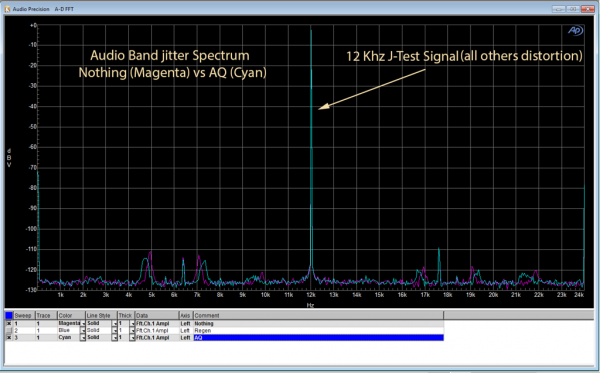Lets start with something simple .What can we tell form this W know it is an FFT courtesy of AMURM.
The most important thing we can tell is that you spelled my name wrong.

BTW, I will be explaining all of this in a series of videos I plan to produce "one of these days!"

Here is the text version. The setup is a computer playing a .wav file. The computer is playing a 12 Khz tone (it has a bit more but that is not important here). A perfect system produces that 12 Khz tone with nothing else. Now, if you looked at that waveform, it would look like a sine wave that it is. We call that "time domain." Unfortunately it is hard to analyze time domain signals visually. What if that sine wave is squashed by .01%? You could not tell that visually although we have clearly distorted the signal.
What we do to make the analysis simpler, or even possible, is to convert that "time domain" signal into "frequency domain." A guy by the name of Fourier proved that we can do that for infinitely running signals. We don't have infinite signal but for the purposes of this analysis, let's say we have plenty of it. FFT is a computer optimization of that transform that makes it run a lot faster.
In this situation, I have an audio analyzer that has an analog to digital converter. It captures whatever my DAC is producing. Once there, it has a digital representation in time. It applies the FFT to it and produces the graph that you see.
The graph faithfully shows that 12 Khz that we were playing. If my DAC and the ADC in the analyzer were ideal/perfect, that is all we would see. We don't see that. What we see are:
1. Additional spikes at certain frequencies. We have one at 5 Khz for example in purple. This says that if we play a pure 12 Khz tone at this level, the system will produce the 12 Khz but also add to it this 5 Khz tone. Clearly the 5 Khz is distortion. This distortion may be related to the frequency of the tone we are playing in which case we call it "correlated." Or it could always be there like 60 Hz hum from mains in which case it is "uncorrelated."
Now, we don't play single tones but music. Music can be decomposed into a sequence of single tones. If anytime we play a tone, we get another little sister of it 7 Khz lower (i.e. 12 Khz - 5 Khz), then the same thing will happen to every tone in your music. There will then be a spray of such extra tones corresponding to the rich spectrum of your music.
2. The second thing we see is noise. These are the random looking little ripples at the bottom. This information is not to be used in this analysis. The reason is that we averaged the 8 separate captures. Random noise then adds and subtracts from itself and its *measured* level lowers. We further can analyze the signal at higher resolution than its sampling rate, which again lowers the measured noise. In other words, we have optimized the system to have least amount of measurement noise to show up those little spikes. In reality, if you just listened to the DAC, its noise floor would be higher than these exceedingly small levels.
All of this tells us the meaning of measurements. It doesn't say any of this is necessarily bad from audibility point of view. That is a much more complicated topic.


















